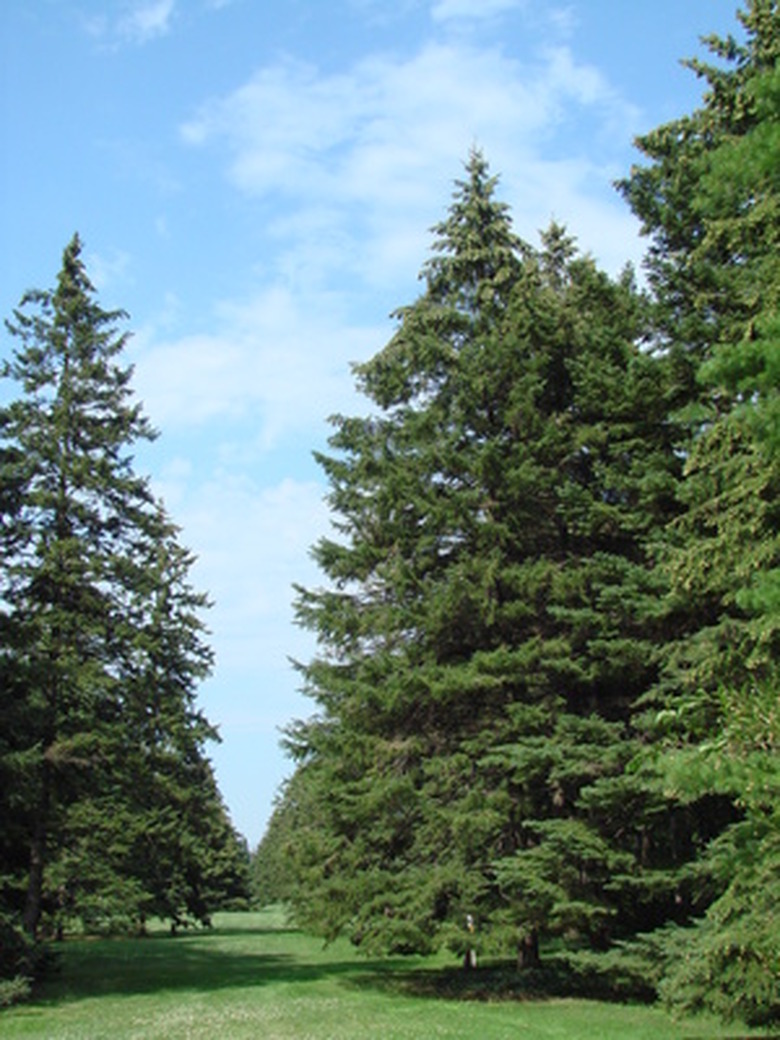Fertilizer For Pine Trees
Knowing how and when to fertilize pine trees is essential to keeping them healthy and maintaining their vibrancy and color. However pines, like nearly all evergreens, require far less fertilizer than most other plants. Pine trees are a hardy species and usually obtain sufficient food from most types of soil. Over-fertilizing can cause burned roots or make the tree weaker due to rapid growth. The less-is-more rule is certainly good to bear mind with pines.
Fertilizing at Planting
As a general rule, it is best not fertilize pine trees when they are planted. During transplanting the trees are under great stress and adding fertilizer at this point may be enough to kill them. Never put fertilizer into the planting hole where it can come into contact with the root ball. Not fertilizing for the first three to 6 months will stimulate young pines to spread their root system and develop long tap roots that reach deeper nutrients and water within the soil.
- Knowing how and when to fertilize pine trees is essential to keeping them healthy and maintaining their vibrancy and color.
- As a general rule, it is best not fertilize pine trees when they are planted.
Fertilizing Pine Trees After Planting
If you plant your pine in the fall, apply your first dose of fertilizer in the spring. For trees planted in the spring, wait approximately three months. According to Dennis Patton, Extension Horticulture Agent with Kansas State University, "the proper rate of application is dependent on the diameter of the tree measured four and one-half feet above the ground." Measure the circumference and divide by 3.14 to find out the diameter. Patton goes on to recommend applying 1 lb. of fertilizer per inch of tree diameter. If the tree diameter is more than 6 inches, increase the fertilizer by another 1/2 lb. per inch.
- If you plant your pine in the fall, apply your first dose of fertilizer in the spring.
- According to Dennis Patton, Extension Horticulture Agent with Kansas State University, "the proper rate of application is dependent on the diameter of the tree measured four and one-half feet above the ground."
Types and Application
Use a balanced fertilizer containing between 6 and 12 percent nitrogen. Fertilizers are labeled using a numeric format such as 10-10-10. The numbers represent the percentage of nitrogen, phosphorus and potassium (N-P-K) contained in the fertilizer. A balanced fertilizer simply means that each of the N-P-K quantities are the same as in 12-12-12. Spread the fertilizer evenly on the ground making sure it does not touch the trunk. Fertilize pine trees to one and 1/2 times the drip line, which is the furthest point that the branches extend out from the tree. For example, if the drip line for your tree is 10 feet, you should fertilize out to 15 feet.
- Use a balanced fertilizer containing between 6 and 12 percent nitrogen.
- A balanced fertilizer simply means that each of the N-P-K quantities are the same as in 12-12-12.
Fertilize Pine Trees by Mulching
The forest floor is covered by a layer of decomposing material which continually enriches the soil with nutrients. Most homeowners keep their lawns clear of leaves and other organic material which deprives trees of their natural food source. Maintaining a mulch ring around your trees will simulate the forest environment. Good mulch consists of pine needles, bark and leaves. It should be spread from within a few feet of the trunk out to the drip line. According to horticulture expert Jeff Ball, maintaining a good mulch ring should mean there's no need to fertilize pine trees after they reach four to five years of age.
Yellowing Pine Needles
Some yellowing of the needles in the fall is a normal part the growth cycle and should not cause concern. However if the loss of color persists it may indicate other problems. Compacted soil may not allow the fertilizer or nutrients to penetrate the soil properly. Use a spike or metal rod to make 6-inch holes spaced about 3 feet apart around the tree. Divide the recommended amount of pine tree fertilizer evenly and apply it in the holes. If after a month the yellowing of the needles continues, consult your local tree specialist to get expert advice on the possible causes.
- The forest floor is covered by a layer of decomposing material which continually enriches the soil with nutrients.
- According to horticulture expert Jeff Ball, maintaining a good mulch ring should mean there's no need to fertilize pine trees after they reach four to five years of age.
